
The mountains and Li River of Guilin.
The Li River is one of the must-go as instructed in the book "1000 places to See Before You Die." I was however a little bit disappointed, mainly because we took the beaten path and did what eveybody does when they go to Guilin: the 5-hour river cruise. It was torturous for me because we were stuck in the upper cabin of the boat with 10 other locals, three of them who smoked despite the no smoking signs and even when told not to. The food was simply not fit for eating and the squat toilet-it was like the river banks had burst. I nearly passed out not breathing, and kept thinking: my new Nikes! my new Nikes! Chinese authorities take note: I saw rubbish and leftovers and dishwashing water thrown overboard! Into your beloved Li River! It's a shame! I'd advise travellers to take a short boat ride to see the mountains and the river ("Quilin xhanxhui") and go to a quaint town called 'Yangshou' for a couple of days. I saw a lot of westerners, backpackers lodges and pubs but still it'll give you a real feel of the rustic country living with those old houses and streets and famous jagged hills all around.
The mountains of Guilin as seen from the Li River is so beautiful that it is captured in the RMB20 note. It was very beautiful, the unusual shapes of the limestone hills, the bamboo groves and the clear water. However, December is when the water level of the river is at its lowest, so the scenery may not be as good as, say, in April.
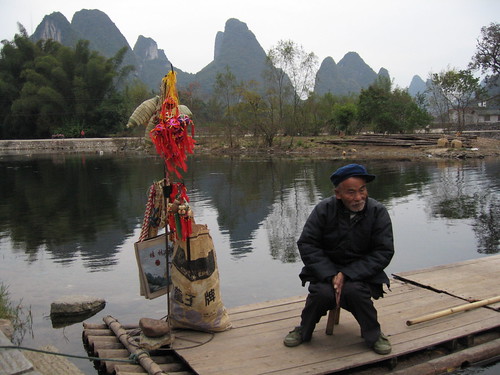
At the 'Liushanje' Park. Or some name like that.
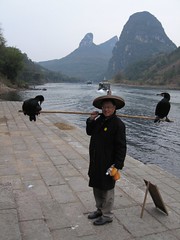
Man with cormorants.
Yes, its hubby doing a good job of balancing the birds on his shoulders. These poor birds have a ring on their necks to stop them from eating the fish that they catch so their owners can have the fish for themselves.
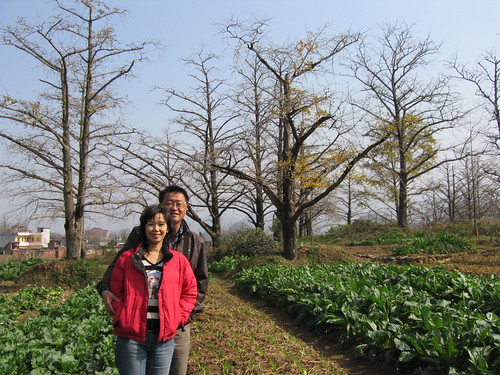
The gingko trees of Guilin. And us.
This is where they shoot movies when the gingko leaves turn yellow. My niece and her hub took a day off to drive us hours to this area where gingko is grown. However when we got there we were told rain came 4 days before that and the lovely yellow autumn leaves have all fallen. Even the fallen leaves were gone because all had been gathered to make gingko pills, something I should take because its supposed to improve my memory. It is said that as long as each family has a gingko tree they are rich.
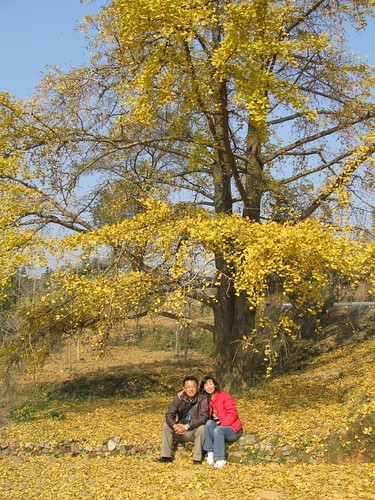
The lone tree that still had leaves.
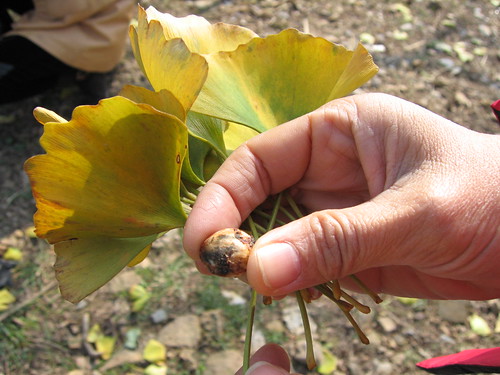
Gingko seed.
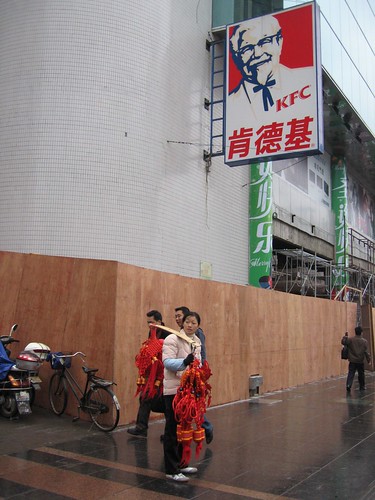
Girl selling hand-knotted 'prosperity' knots.
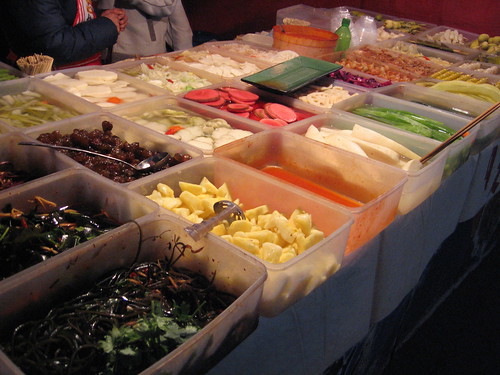
Veg and fruits pickles.
They love their pickles, those Guilin people. Now I know why Mom loves pickles-she studied in this city.

Guilin products.
The bag of yellow stuff (top left) is dried 'guihwa,' flowers from a tree grown for its fragrant flowers that is used to flavor desserts and cakes, like vanilla. The city, named after this flower, is planted with this tree and you can smell it everywhere. The balls are 'lohanguo,' a fruit that 'cools' your body if you eat too much fried food. At the bottom left is another famous Guilin produce, gingko seeds.
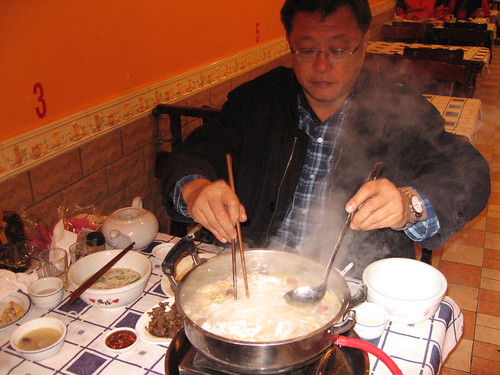
Firepot dinner of native chicken with herbs soup.
This was a really good meal. It was cold out (5 C), the firepot was warming and comforting. It was also very tasty, the chicken being 'native' or wild. The shopowner was horrified when we asked for a bowl of plain Guilin meefern/rice noodles which we dumped into the soup. She told us that's not the way to eat firepot, but we told her we just love the noodles, and she concluded that we are from Taiwan. We also enjoyed a wonderful firepot lunch of native chicken gingko soup at the gingko growing village. Don't be put off by the chicken head, butt and a few small feathers in the soup!
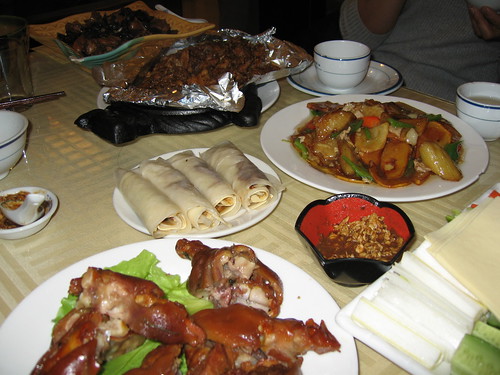
This meal was excellent, full of spicy flavor, and cost only RMB80, for 4 people. And all the food wasn't on the table yet.
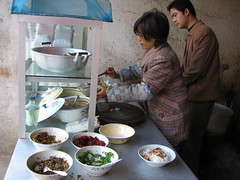
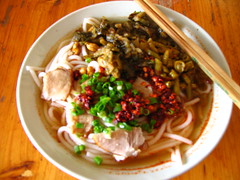
This was the BEST bowl of Guilin noodles. Situated at the entrance of the ancient town, the restaurant is run by this lady and her son who make the most delicious bowl of noodles, better than any I have ever tasted. Apparently only the locals know where to find it. And it only costs RMB2.50 (less than US$0.35) a bowl. I noted down the topping: boiled pork slices, pickled long beans, deep-fried soybeans, preserved veg, chili paste, spring onions-only to be told the soup is made from 72 secret ingredients! How's that KFC? If I ever go back to Guilin, I'll eat this noodle everyday of my stay . Although the noodles look like the Penang laksa noodles, they are different in taste and texture. Freshly made, the noodles are moist yet el dente and slippery-smooth and full of the fragrance of freshly-cooked rice. Traditionally Guilin noodles are served with thin slices of horsemeat (we did try that, but the meat was too paper-thin to be of any taste and my niece said its unlikely to be the real McCoy because horse meat is rare and expensive).
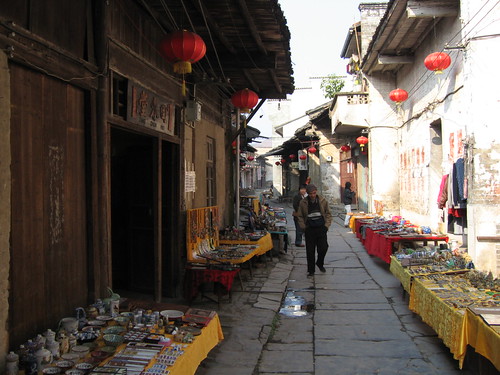
The young people have left for the city and the old folks stayed behind, opening their houses to tourists (some charge, some don't) and selling whatever knick knacks from their homes. So few people come that the folks don't bother to stay by their stalls.

This grandma was very friendly. She was having a simple firepot lunch of chinese cabbage and pork. It looked yummy. The firepot is very popular in China in the winter.
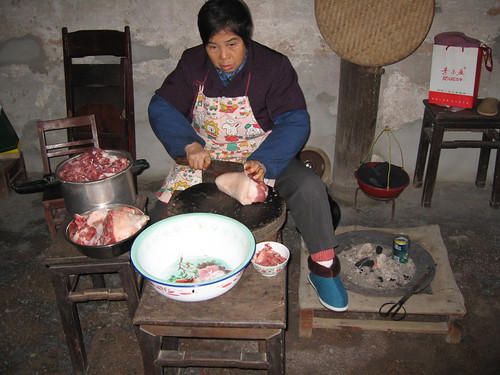
Making sausages.
This lady was making pork sausages which would be cured in the winter wind. She wasn't very happy with us dropping by. The stove of charcoal at her feet is to keep her warm.
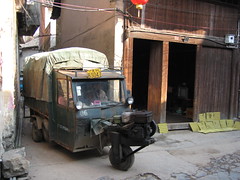
WW1 vehicle?
I half-expected soldiers and gunfire when this vehicle suddenly appeared!
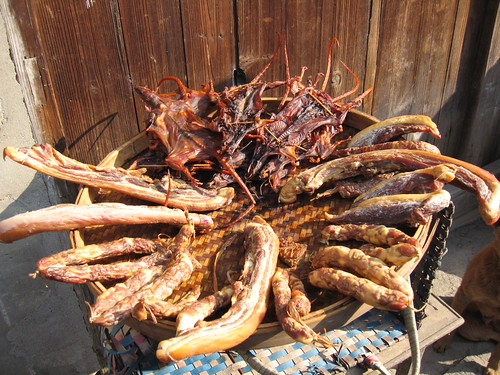
Curing meat in the winter sun.
Drying homemade sausages, pork belly strips and--rats! What's China without some dried rats eh?!

1 comment:
i love seeing these pictures of authentic life in China.
Post a Comment